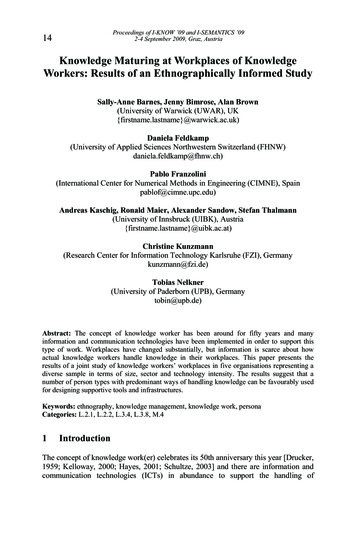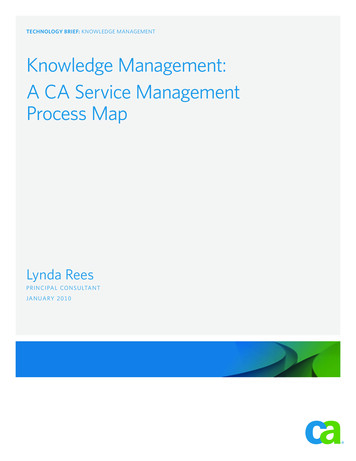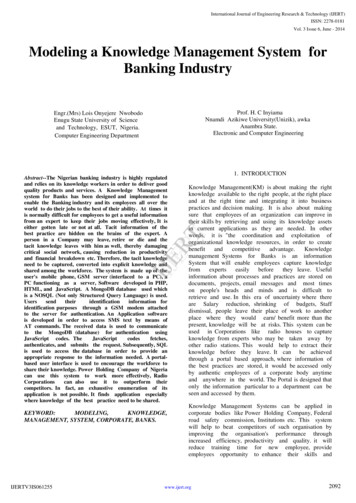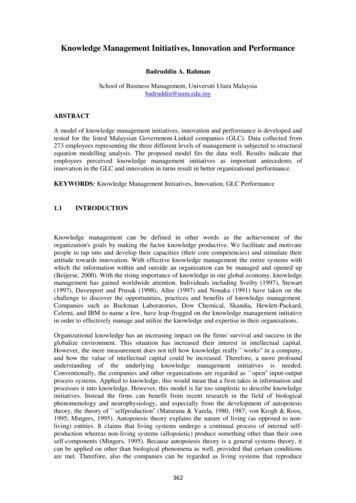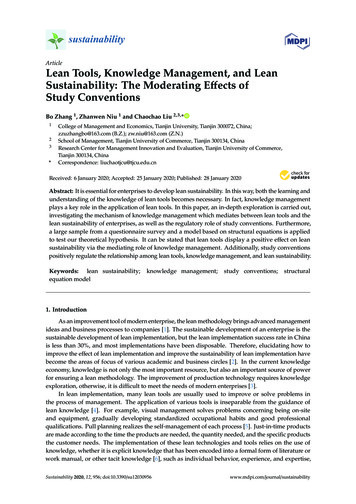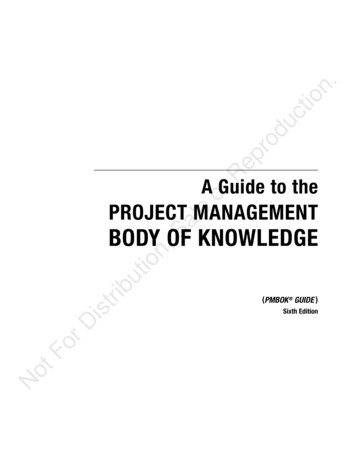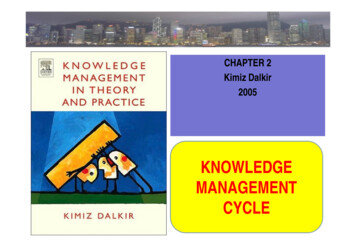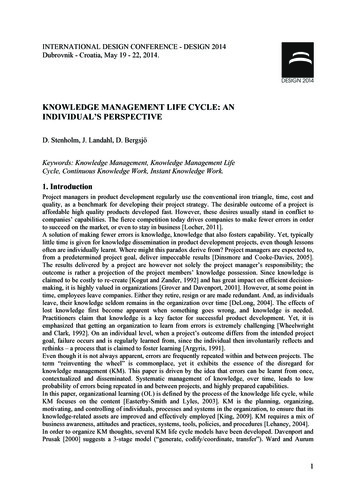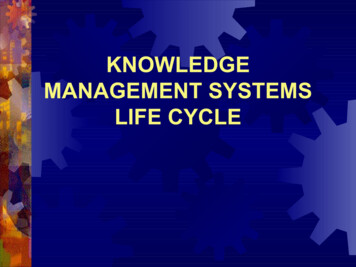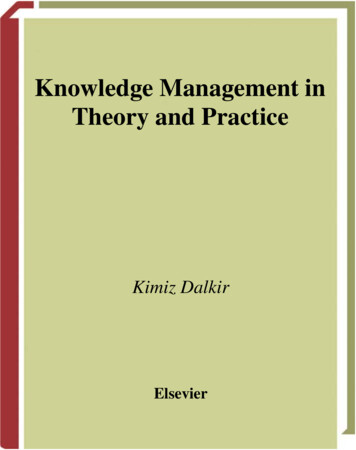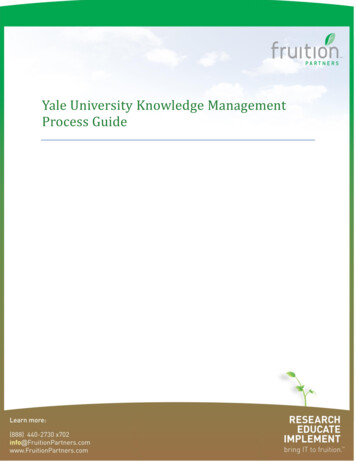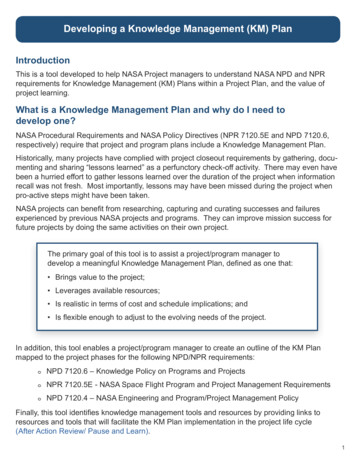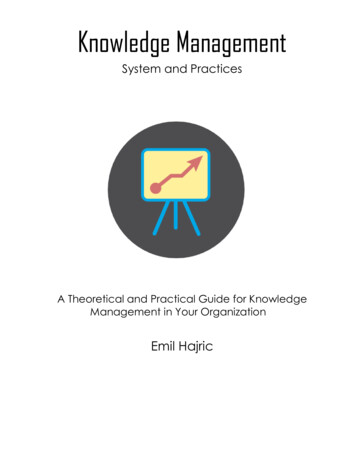
Transcription
Knowledge ManagementSystem and PracticesA Theoretical and Practical Guide for KnowledgeManagement in Your OrganizationEmil Hajric
Copyright 2018 Emil HajricAll Rights Reserved
IntroductionThis is a knowledge management book covering the theories, frameworks,models, tools, and supporting disciplines that are relevant to both the student andthe practitioner. The goal of this book is to provide a comprehensive overview ofknowledge management by examining its objectives, scope, strategy, best practices,knowledge management tools, and so on. The book is structured very much like atextbook, with introductory concepts at the top, more subject-specific discussionsin the latter half.
Introducing KnowledgeManagement
Knowledge management is essentiallyabout getting the right knowledge to theright person at the right time. This in itselfmay not seem so complex, but it implies astrong tie to corporate strategy,understanding of where and in what formsknowledge exists, creating processes thatspan organizational functions, and ensuringthat initiatives are accepted and supportedby organizational members. Knowledgemanagement may also include newknowledge creation, or it may solely focus onknowledge sharing, storage, and refinement.For a more comprehensive discussion anddefinition, see my knowledge management definition.It is important to remember that knowledge management is not about managingknowledge for knowledge's sake. The overall objective is to create value andleverage and refine the firm's knowledge assets to meet organizational goals.Implementing knowledge management thus has several dimensions including:Strategy: Knowledge management strategy must be dependent on corporatestrategy. The objective is to manage, share, and create relevant knowledge assetsthat will help meet tactical and strategic requirements.Organizational Culture: The organizational culture influences the way peopleinteract, the context within which knowledge is created, the resistance they willhave towards certain changes, and ultimately the way they share (or the way theydo not share) knowledge.Organizational Processes: The right processes, environments, and systems thatenable KM to be implemented in the organization.Management & Leadership: KM requires competent and experienced leadershipat all levels. There are a wide variety of KM-related roles that an organization mayor may not need to implement, including a CKO, knowledge managers, knowledgebrokers and so on. More on this in the section on KM positions and roles.Technology: The systems, tools, and technologies that fit the organization'srequirements - properly designed and implemented.
Politics: The long-term support to implement and sustain initiatives that involvevirtually all organizational functions, which may be costly to implement (both fromthe perspective of time and money), and which often do not have a directly visiblereturn on investment.In the past, failed initiatives were often due to an excessive focus on primitiveknowledge management tools and systems, at the expense of other areas. While itis still true that KM is about people and human interaction, KM systems have comea long way and have evolved from being an optional part of KM to a criticalcomponent. Today, such systems can allow for the capture of unstructured thoughtsand ideas, can create virtual conferencing allowing close contact between peoplefrom different parts of the world, and so on. This issue will also be addressedthroughout the site, and particularly in the knowledge management strategysection.At this point, the articles presented on this site focus on the first five dimensions.For now, at least, the political dimension is beyond the scope of this site.Throughout the site, I will explain and discuss known theories, occasionallycontributing with some of my own frameworks. I will also discuss the potential roleof knowledge management systems from a broad perspective, and in the section onKM tools I will provide specific advice on this topic. I have tried to organize the siteas logically as possible, moving from a general introduction to knowledge and KMto introducing key subjects like organizational memory, learning, and culture. Thelater sections discuss several models and frameworks as well as knowledgemanagement initiatives, strategy, and systems, before finally presenting anoverview of various tools and techniques.
Knowledge, Information andData
Defining Knowledge, Information, DataBefore one can begin to talk about knowledge management (KM), one must startby clearly defining the meaning of the word "knowledge". It is important tounderstand what constitutes knowledge and what falls under the category ofinformation or data. Unfortunately, this is a more difficult task than may beapparent at first. Within everyday language, within specific fields, and even withinthe same disciplines, the word "knowledge" often takes on a variety of meanings.Perspectives on Knowledge, Information, DataIn everyday language we use knowledge all the time. Sometimes we mean knowhow, while other times we are talking about wisdom. On many occasions we evenuse it to refer to information. Part of the difficulty of defining knowledge arises fromits relationship to two other concepts, namely data and information. These twoterms are often regarded as lower denominations of knowledge, but the exactrelationship varies greatly from one example to another.Within more technologically oriented disciplines- particularly involvinginformation systems- knowledge is often treated very similarly to information. It isseen as something one can codify and transmit, and where IT plays a pivotal role inknowledge sharing. For instance, the encyclopedia at fact-archive.com defines it as:"information that has a purpose or use."This kind of simplistic view of knowledge was particularly widespread during the90s when information technology became increasingly more common. Howevereven today, some KM systems are little more than information managementsystems using knowledge as a virtual synonym for information.To illustrate, Theirauf (1999) defines the three components as follows: data is thelowest point, an unstructured collection of facts and figures; information is the nextlevel, and it is regarded as structured data; finally, knowledge is defined as"information about information".However, increasingly one sees definitions that treat knowledge as a morecomplex and personal concept that incorporate more than just information. TheLongman online dictionary has one definition that begins to approach the way thatknowledge is usually regarded within KM. It states "the information, skills, andunderstanding that you have gained through learning or experience." Although still
closely associated with information, concepts like skills, understanding, andexperience begin to surface.Defining Data, Information, and KnowledgeHere, I have included the definitions that will be used throughout this book.Data: Facts and figures which relay something specific, but which are notorganized in any way and which provide no further information regarding patterns,context, etc. I will use the definition for data presented by Thierauf (1999):"unstructured facts and figures that have the least impact on the typical manager."Information: For data to become information, it must be contextualized,categorized, calculated and condensed (Davenport & Prusak 2000). Informationthus paints a bigger picture; it is data with relevance and purpose (Bali et al 2009).It may convey a trend in the environment, or perhaps indicate a pattern of sales fora given period of time. Essentially information is found "in answers to questions thatbegin with such words as who, what, where, when, and how many" (Ackoff 1999).IT is usually invaluable in the capacity of turning data into information, particularlyin larger firms that generate large amounts of data across multiple departments andfunctions. The human brain is mainly needed to assist in contextualization.
Knowledge: Knowledge is closely linked to doing and implies know-how andunderstanding. The knowledge possessed by each individual is a product of hisexperience and encompasses the norms by which he evaluates new inputs from hissurroundings (Davenport & Prusak 2000). I will use the definition presented byGamble and Blackwell (2001), based closely on a previous definition by Davenport& Prusak:"Knowledge is a fluid mix of framed experience, values, contextual information,expert insight, and grounded intuition that provides an environment and frameworkfor evaluating and incorporating new experiences and information. It originates andis applied in the mind of the knowers. In organizations it often becomes embeddednot only in documents or repositories, but also in organizational routines, practicesand norms."In order for KM to succeed, one needs a deep understanding of what constitutesknowledge. Now that we have set clear boundaries between knowledge,information, and data, it is possible to go one step further and look at the forms inwhich knowledge exists and the different ways that it can be accessed, shared, andcombined. I will discuss this in the section titled "The Different Kinds of Knowledge".
The Different Types of KnowledgeUnderstanding the different forms that knowledge can exist in, and thereby beingable to distinguish between various types of knowledge, is an essential step forknowledge management (KM). For example, it should be fairly evident that theknowledge captured in a document would need to be managed (i.e. stored,retrieved, shared, changed, etc.) in a totally different way than that gathered overthe years by an expert craftsman.Over the centuries many attempts have been made to classify knowledge, anddifferent fields have focused on different dimensions. This has resulted in numerousclassifications and distinctions based in philosophy and even religion. Though notdirectly related to our purpose here, the Wikipedia article on knowledge providessome interesting background reading (go to article).Within business and KM, two types of knowledge are usually defined, namelyexplicit and tacit knowledge. The former refers to codified knowledge, such as thatfound in documents, while the latter refers to non-codified and oftenpersonal/experience-based knowledge.KM and organizational learning theory almost always take root in the interactionand relationship between these two types of knowledge. This concept has beenintroduced and developed by Nonaka in the 90's (e.g. Nonaka 1994) and remains atheoretical cornerstone of this discipline. Botha et al (2008) point out that tacit andexplicit knowledge should be seen as a spectrum rather than as definitive points.Therefore, in practice, all knowledge is a mixture of tacit and explicit elementsrather than being one or the other. However, in order to understand knowledge, itis important to define these theoretical opposites.Some researchers make a further distinction and talk of embedded knowledge.This way, one differentiates between knowledge embodied in people and thatembedded in processes, organizational culture, routines, etc. (Horvath 2000).Gamble and Blackwell (2001) use a scale consisting of represented-embodiedembedded knowledge, where the first two closely match the explicit-tacit.Without question, the most important distinction within KM is between explicitand tacit knowledge. However, I find that the embedded dimension is a valuableaddition, since the managerial requirements for this type of knowledge are quite
different. For this reason, the discussions on this site will, when relevant, use allthree categorizations of knowledge but the focus will always be primarily on theexplicit-tacit dimension.Below I present an overview of these three categories, as well as a shortdiscussion on the way knowledge management systems (KMS) can/cannot be usedto manage them.Explicit KnowledgeThis type of knowledge is formalized and codified and is sometimes referred to asknow-what (Brown & Duguid 1998). It is therefore fairly easy to identify, store, andretrieve (Wellman 2009). This is the type of knowledge most easily handled by KMS,which are very effective at facilitating the storage, retrieval, and modification ofdocuments and texts.From a managerial perspective, the greatest challenge with explicit knowledge issimilar to information. It involves ensuring that people have access to what theyneed; that important knowledge is stored; and that the knowledge is reviewed,updated, or discarded.Many theoreticians regard explicit knowledge as being less important (e.g. Brown& Duguid 1991, Cook & Brown 1999, Bukowitz & Williams 1999, etc.). It isconsidered simpler in nature and cannot contain the rich experience-based knowhow that can generate lasting competitive advantage.Although this is changing to some limited degree, KM initiatives driven bytechnology have often had the flaw of focusing almost exclusively on this type ofknowledge. As discussed previously, in fields such as IT there is often a lack of a moresophisticated definition. This has therefore created many products labeled as KMsystems, which in actual fact are/were nothing more than information and explicitknowledge management software.Explicit knowledge is found in: databases, memos, notes, documents, etc. (Bothaet al. 2008)Tacit KnowledgeThis type of knowledge was originally defined by Polanyi in 1966. It is sometimesreferred to as know-how (Brown & Duguid 1998) and refers to intuitive, hard todefine knowledge that is largely experience based. Because of this, tacit knowledge
is often context dependent and personal in nature. It is hard to communicate anddeeply rooted in action, commitment, and involvement (Nonaka 1994).Tacit knowledge is also regarded as being the most valuable source of knowledge,and the most likely to lead to breakthroughs in the organization (Wellman 2009).Gamble & Blackwell (2001) link the lack of focus on tacit knowledge directly to thereduced capability for innovation and sustained competitiveness.KMS have a very hard time handling this type of knowledge. An IT system relieson codification, which is something that is difficult/impossible for the tacitknowledge holder.Using a reference by Polanyi (1966), imagine trying to write an article that wouldaccurately convey how one reads facial expressions. It should be quite apparent thatit would be near impossible to convey our intuitive understanding gathered fromyears of experience and practice. Virtually all practitioners rely on this type ofknowledge. An IT specialist for example will troubleshoot a problem based on hisexperience and intuition. It would be very difficult for him to codify his knowledgeinto a document that could convey his know-how to a beginner. This is one reasonwhy experience in a particular field is so highly regarded in the job market.
The exact extent to which IT systems can aid in the transfer and enhancement oftacit knowledge is a rather complicated discussion. For now, suffice it to say thatsuccessful KM initiatives must place a very strong emphasis on the tacit dimension,focusing on the people and processes involved, and using IT in a supporting role.Tacit knowledge is found in: the minds of human stakeholders. It includes culturalbeliefs, values, attitudes, mental models, etc. as well as skills, capabilities andexpertise (Botha et al 2008). On this site, I will generally limit tacit knowledge toknowledge embodied in people and refer separately to embedded knowledge (asdefined below), whenever making this distinction is relevant.Embedded KnowledgeEmbedded knowledge refers to the knowledge that is locked in processes,products, culture, routines, artifacts, or structures (Horvath 2000, Gamble &Blackwell 2001). Knowledge is embedded either formally, such as through amanagement initiative to formalize a certain beneficial routine, or informally as theorganization uses and applies the other two knowledge types.The challenges in managing embedded knowledge vary considerably and willoften differ from embodied tacit knowledge. Culture and routines can be bothdifficult to understand and hard to change. Formalized routines on the other handmay be easier to implement and management can actively try to embed the fruitsof lessons learned directly into procedures, routines, and products.IT's role in this context is somewhat limited but it does have some usefulapplications. Broadly speaking, IT can be used to help map organizational knowledgeareas; as a tool in reverse engineering of products (thus trying to uncover hiddenembedded knowledge); or as a supporting mechanism for processes and cultures.However, it has also been argued that IT can have a disruptive influence on cultureand processes, particularly if implemented improperly.Due to the difficulty in effectively managing embedded knowledge, firms thatsucceed may enjoy a significant competitive advantage.Embedded knowledge is found in: rules, processes, manuals, organizationalculture, codes of conduct, ethics, products, etc. It is important to note, that whileembedded knowledge can exist in explicit sources (i.e. a rule can be written in amanual), the knowledge itself is not explicit, i.e. it is not immediately apparent whydoing something this way is beneficial to the organization.
What is KnowledgeManagement?
The full scope of knowledge management (KM) is not something that is universallyaccepted. However, before one looks at the differences in the definitions, let's thesimilarities.KM is about making the right knowledge available to the right people. It is aboutmaking sure that an organization can learn, and that it will be able to retrieve anduse its knowledge assets in current applications as they are needed. In the words ofPeter Drucker it is "the coordination and exploitation of organizational knowledgeresources, in order to create benefit and competitive advantage" (Drucker 1999).Where the disagreement sometimes occurs is in conjunction with the creation ofnew knowledge. Wellman (2009) limits the scope of KM to lessons learned and thetechniques employed for the management of what is already known. He argues thatknowledge creation is often perceived as a separate discipline and generally fallsunder innovation management.Bukowitz and Williams (1999) link KM directly to tactical and strategicrequirements. Its focus is on the use and enhancement of knowledge-based assetsto enable the firm to respond to these issues. According to this view, the answer tothe question "what is knowledge management" would be significantly broader.A similarly broad definition is presented by Davenport & Prusak (2000), whichstates that KM "is managing the corporation's knowledge through a systematicallyand organizationally specified process for acquiring, organizing, sustaining,applying, sharing and renewing both the tacit and explicit knowledge of employeesto enhance organizational performance and create value."I will also choose to answer the question "what is knowledge management" in thebroader perspective, encompassing not just the exploitation and management ofexisting knowledge assets, but the also the initiatives involved in the creation andacquisition of new knowledge. In the next article, I will arrive at a specific knowledgemanagement definition.
Knowledge Management DefinitionBased on the discussion in the previous section, my knowledge managementdefinition is as follows:Knowledge management is the systematic management of an organization'sknowledge assets for the purpose of creating value and meeting tactical & strategicrequirements; it consists of the initiatives, processes, strategies, and systems thatsustain and enhance the storage, assessment, sharing, refinement, and creation ofknowledge.Knowledge management (KM) therefore implies a strong tie to organizationalgoals and strategy, and it involves the management of knowledge that is useful forsome purpose an
Knowledge management may also include new knowledge creation, or it may solely focus on knowledge sharing, storage, and refinement. For a more comprehensive discussion and definition, see my knowledge management definition. It is important to remember that knowledge management is not about managing
